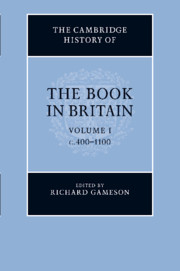Book contents
- Frontmatter
- 1 From Vindolanda to Domesday: the book in Britain from the Romans to the Normans
- PART I THE MAKING OF BOOKS
- 2 The material fabric of early British books
- 3 Anglo-Saxon scribes and scriptoria
- 4 Writing in the Insular world
- 5 Script in Wales, Scotland and Cornwall
- 6 English vernacular script
- 7 Latin script in England c. 900–1100
- 8 The design and decoration of Insular gospel-books and other liturgical manuscripts, c. 600 – c. 900
- 9 The decoration of the earliest Welsh manuscripts
- 10 Book decoration in England, c. 871 – c. 1100
- 11 Bookbindings
- PART II THE CIRCULATION OF BOOKS
- PART III TYPES OF BOOKS AND THEIR USES
- PART IV COLLECTIONS OF BOOKS
- PART V CODA
- Bibliography
- Concordance of named manuscripts
- Index of manuscripts
- General Index
- Plate 4.1: The Lindisfarne Gospels"
- Plate 5.1: The Lichfield/St Chad Gospels"
6 - English vernacular script
from PART I - THE MAKING OF BOOKS
Published online by Cambridge University Press: 28 March 2012
- Frontmatter
- 1 From Vindolanda to Domesday: the book in Britain from the Romans to the Normans
- PART I THE MAKING OF BOOKS
- 2 The material fabric of early British books
- 3 Anglo-Saxon scribes and scriptoria
- 4 Writing in the Insular world
- 5 Script in Wales, Scotland and Cornwall
- 6 English vernacular script
- 7 Latin script in England c. 900–1100
- 8 The design and decoration of Insular gospel-books and other liturgical manuscripts, c. 600 – c. 900
- 9 The decoration of the earliest Welsh manuscripts
- 10 Book decoration in England, c. 871 – c. 1100
- 11 Bookbindings
- PART II THE CIRCULATION OF BOOKS
- PART III TYPES OF BOOKS AND THEIR USES
- PART IV COLLECTIONS OF BOOKS
- PART V CODA
- Bibliography
- Concordance of named manuscripts
- Index of manuscripts
- General Index
- Plate 4.1: The Lindisfarne Gospels"
- Plate 5.1: The Lichfield/St Chad Gospels"
Summary
In Tudor England access to the written word was constrained not simply by an individual’s acquisition of letters, by his (or her) linguistic knowledge, but by mastery of script and print types. Those who could read print could not necessarily construe script, while black-letter literacy ‘was a more basic skill than roman-type literacy’. When readers in eleventh-century England were faced with a similar visual distinction in the presentation of the written word, their levels of literacy were tested more absolutely. Caroline Minuscule, the script of Charlemagne’s court and of the universalising aspirations of the reformed church on the Continent, conveyed Latin text; Insular Minuscule, the indigenous product practised only by the English, which employed letter-forms in use in Britain and Ireland for at least three centuries, served as the medium for the vernacular. The visual separation of languages in the three generations before the Norman Conquest constitutes a central and immovable fact in early English cultural history. By 1000, the foreign script, with its imported letter-forms and technical challenges for writers and, no doubt, novice readers, signalled the presence of Latin. English, meanwhile, remained within a familiar and instantly recognisable domestic tradition: the language written by scribes and scholars in their ordinary script. Insular Minuscule proliferated as writing in the vernacular took off on a scale unprecedented within the limits of former Roman Europe.
Keywords
- Type
- Chapter
- Information
- The Cambridge History of the Book in Britain , pp. 174 - 186Publisher: Cambridge University PressPrint publication year: 2011
- 2
- Cited by



